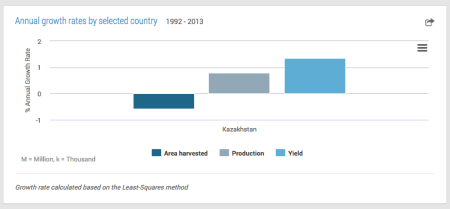We’re great fans here of featuring maps of the distribution of different crops around the world. You may have noticed that. And, perhaps inevitably, when we do, we more often than not succumb to the temptation of making some comment or other about the ecogeographic limits of said distribution. It’s rare, however, that we get to ground-truth our observations. So imagine my joy when the following tweet appeared a few days back:
Once were rice paddies on arid land close to Aral Sea boundaries: tremendous helicopter flight over region. @UNDPKAZ pic.twitter.com/AQtXQHlObc
— Helen Clark (@HelenClarkNZ) May 24, 2015
Because we had commented some years ago on rice cultivation in Kazakhstan, in particular how it seems to be hanging on just on the edge of the northern limit of the crop. Well, as the photo in the tweet suggests, maybe “hanging on” is too strong a phrase, though being at the northern limit of its range is perhaps not the main reason for that, at least around the Aral Sea. Although FAOStat records an overall decrease in area harvested since 1992, yields do seem to be holding up.

Incidentally, Genesys knows of almost 300 accessions from Kazakhstan, mainly, but not entirely, from VIR. I’m reliably informed material from Kazakhstan is among the most cold tolerant in the world, which you’d probably expect.